
Types of Motorcycle Batteries
Understanding the different types of batteries, how to maintain them, and the tools available for charging and monitoring can save you from unexpected breakdowns and extend the life of your battery. In this article, we’ll explore the types of motorcycle batteries, their pros and cons, essential maintenance tips, and the benefits of using multi-type battery optimisers.
1. Conventional Lead-Acid Batteries
.jpg)
Description: These are the most traditional type of motorcycle batteries, filled with liquid electrolyte (acid).
Pros:
Affordable and widely available.
Reliable performance in most conditions.
Cons:
Require regular maintenance (topping off with distilled water).
Prone to leaking if tipped over.
Shorter lifespan compared to newer technologies.
2. Absorbent Glass Mat (AGM) Batteries
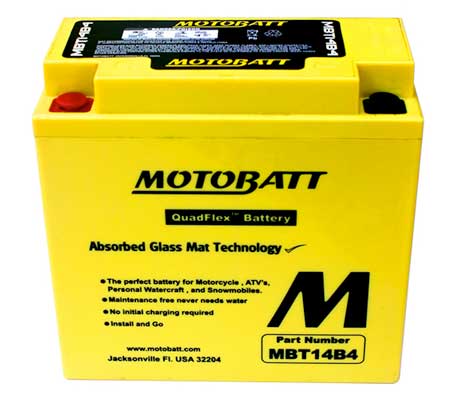
Description: AGM batteries use a fiberglass mat to absorb the electrolyte, making them spill-proof and maintenance-free.
Pros:
No maintenance required.
More resistant to vibration and shock.
Longer lifespan than conventional lead-acid batteries.
Better performance in cold weather.
Cons:
More expensive than conventional batteries.
Sensitive to overcharging.
3. Gel Batteries
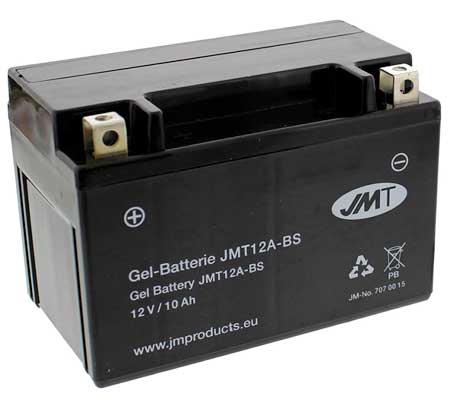
Description: Gel batteries use a gelified electrolyte, making them spill-proof and highly durable.
Pros:
Maintenance-free.
Excellent resistance to vibration and shock.
Long lifespan.
Cons:
Expensive.
Sensitive to overcharging and require a specific charger.
Not ideal for high-current applications.
4. Lithium-Ion Batteries
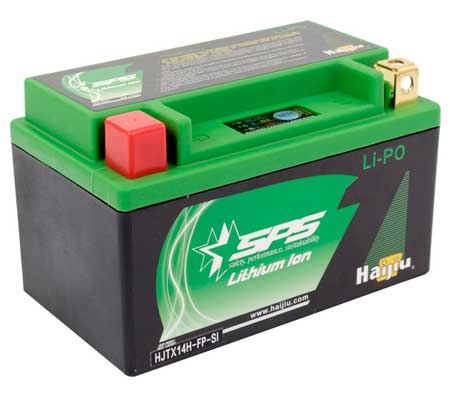
Description: Lithium-ion batteries are the newest technology, offering lightweight and high-performance power.
Pros:
Extremely lightweight (up to 70% lighter than lead-acid batteries).
Long lifespan.
High cranking power, even in cold weather.
Maintenance-free.
Cons:
Expensive.
Requires a specific charger designed for lithium-ion batteries.
Can be damaged if over-discharged.
Battery Maintenance Tips
Proper maintenance is key to ensuring your motorcycle battery performs reliably and lasts as long as possible. Here are some essential tips:
1. Keep the Battery Charged
Motorcycle batteries can lose charge over time, especially if the bike is not used regularly. Use a battery maintainer or trickle charger to keep the battery at optimal voltage during storage.
Avoid letting the battery fully discharge, as this can cause permanent damage.
2. Check Electrolyte Levels (for Conventional Batteries)
If you have a conventional lead-acid battery, regularly check the electrolyte levels and top off with distilled water as needed. Never overfill.
3. Clean the Battery Terminals
Corrosion on the battery terminals can hinder performance. Clean the terminals with a mixture of baking soda and water, then apply a thin layer of dielectric grease to prevent future corrosion.
4. Secure the Battery
Ensure the battery is securely mounted to prevent vibration damage, which can shorten its lifespan.
5. Avoid Overcharging
Overcharging can damage any type of battery. Use a charger designed for your specific battery type and follow the manufacturer’s instructions.
6. Store the Battery Properly
If storing your motorcycle for an extended period, remove the battery and store it in a cool, dry place. Keep it charged using a maintainer.
7. Monitor Voltage
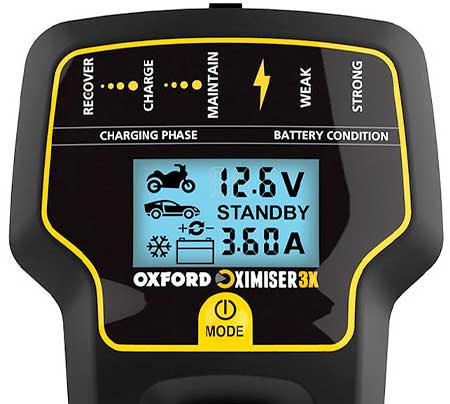
Most chargers will indicate when the battery voltage is low, or if they have a screen may show you the current voltage. Otherwise, use a multimeter to check the battery voltage regularly. A fully charged battery should read around 12.6-12.8 volts when the bike is off and 13.5-14.5 volts when the engine is running.
Multi-Type Battery Optimisers: A Versatile Charging Solution
Modern battery optimisers, or smart chargers, are designed to handle multiple types of batteries, making them a convenient and versatile tool for motorcycle owners. These devices can charge and maintain lithium-ion, AGM, gel, and conventional lead-acid batteries, often with the added benefit of displaying real-time battery voltage on a screen.
Key Features of Multi-Type Battery Optimisers
Compatibility with Multiple Battery Types:
These chargers automatically detect the type of battery connected (lithium-ion, AGM, gel, or lead-acid) and adjust the charging profile accordingly.
This eliminates the need for separate chargers for different battery types.
Voltage Display:
Many optimisers feature an LCD or LED screen that displays the current battery voltage, allowing you to monitor the health of your battery in real time.
This is particularly useful for diagnosing issues like overcharging, undercharging, or a failing battery.
Maintenance Mode:
Smart chargers often include a maintenance or "float" mode, which keeps the battery at an optimal charge level without overcharging. This is ideal for long-term storage.
Safety Features:
Built-in protections against overcharging, short circuits, and reverse polarity ensure safe and reliable charging.
Some models also include temperature sensors to prevent overheating.
Compact and Portable:
Many optimisers are lightweight and compact, making them easy to store and transport.
Benefits of Using a Multi-Type Battery Optimiser
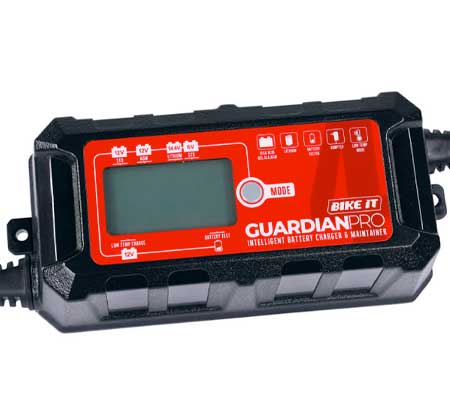
Convenience: One charger for all your battery needs simplifies maintenance and reduces clutter.
Extended Battery Life: Proper charging and maintenance can significantly extend the life of your battery.
Peace of Mind: Real-time voltage monitoring and safety features ensure your battery is always in good condition.
How to Use a Multi-Type Battery Optimiser
Connect the Charger:
Attach the charger’s clamps to the battery terminals (red to positive, black to negative).
Ensure the motorcycle is turned off during charging.
Select the Battery Type (if required):
Some chargers automatically detect the battery type, while others may require manual selection via a button or switch.
Monitor the Voltage:
Check the voltage displayed on the screen. A healthy battery should read around 12.6-12.8 volts when fully charged (for a 12V battery).
For lithium-ion batteries, the voltage should be between 13.2-13.4 volts when fully charged.
Start Charging:
The charger will begin charging the battery using the appropriate profile. Once fully charged, it will switch to maintenance mode.
Disconnect and Store:
After charging, disconnect the charger and store it in a safe place.
Recommended Multi-Type Battery Optimizers
NOCO Genius Series: Known for their versatility and reliability, NOCO chargers can handle all battery types and feature advanced safety protections.
Optimate Series: Specifically designed for motorcycles, Optimate chargers offer multi-stage charging and maintenance modes.
CTEK MXS Series: High-quality chargers with voltage display and compatibility for all battery types.
M&P Technicians Recommend
Our workshop technicians only use Optimate chargers in our workshop.
"While we haven't tested every battery charger, we've found that in a busy workshop environment where the device is in constant use the Optimate is the most reliable and hardwearing. They're also covered by a three year warranty and are trusted by Honda, Ducati, Kawasaki, KTM and Husqvarna.
Even luxury car manufacturers such as Aston Martin and Pagani choose Optimate battery maintenance systems."
Signs of a Failing Battery
Slow cranking: The engine takes longer to start.
Dim lights: Headlights and indicators appear dimmer than usual.
Swollen case: A bulging battery case indicates overheating or overcharging.
Corrosion: Excessive corrosion on the terminals.
Old age: Most motorcycle batteries last 3-5 years, depending on type and usage.
Choosing the Right Battery for Your Motorcycle
When replacing your battery, consider the following:
Compatibility: Check your motorcycle’s manual for the correct battery size, type, and specifications.
Riding conditions: If you ride in extreme temperatures or off-road, opt for a more durable battery like AGM or lithium-ion.
Budget: Balance cost with performance and lifespan.
Conclusion
Motorcycle batteries are a critical component of your bike’s electrical system, and choosing the right type and maintaining it properly can save you time, money, and frustration.
Whether you prefer the affordability of lead-acid batteries or the high performance of lithium-ion, regular maintenance and proper care will ensure your battery delivers reliable power for years to come.
By using a multi-type battery optimiser, you can simplify maintenance, monitor voltage, and extend the life of your battery. With the tips and tools outlined in this article, you’ll be well-equipped to keep your motorcycle battery in top condition and enjoy worry-free rides.
If you have any more questions or need further clarification, feel free to ask! Safe riding!








